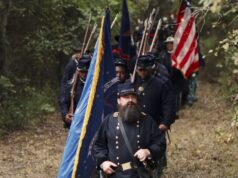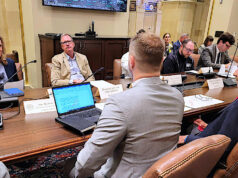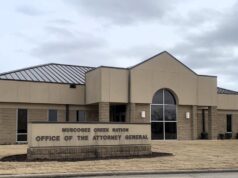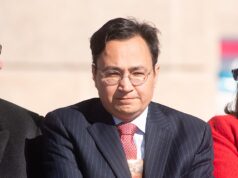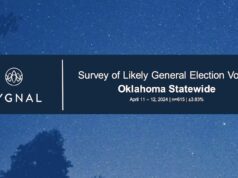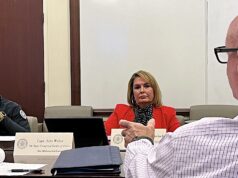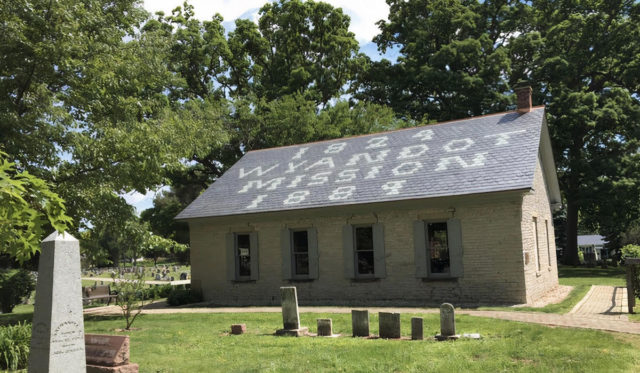

Billy Friend was standing where his ancestors stood.
Over the past decade, Friend, the chief of the Wyandotte Nation, had been making an annual trek to this very spot in Upper Sandusky, Ohio. But this was the first time he had been able to bring a large group of other tribal citizens with him. He couldn’t help but think about the last time his people had gathered here, in 1843, as they turned their backs on the squat mission and began the long journey to Kansas.
Now, in 2019, 120 Wyandotte walked through Upper Sandusky, passing streets named for their ancestors and homes where their great-grandparents were raised. Many of them would see the old mission church for the first time. The unassuming, one-room brick building had been restored over the years — the faded green shutters were new, as was the roof, where a pattern in the shingles spelled out “1824, WYANDOT MISSION, 1889,” in commemoration of its first restoration.
The Wyandot Mission Church, built in 1824, served as an important touchstone for the tribe before it was pushed to Kansas and then to Oklahoma. Now it is also an emblem of what has come to be known as the Land Back movement.
On Sept. 21, 2019, the United Methodist Church officially returned three acres of land, including the mission church, to the Wyandottes, making it one of the first religious organizations to return land to Indigenous people.
“It was a great day for the Wyandotte Nation,” Friend said.
The Wyandottes are one of 574 federally recognized tribal nations in the United States. All of these tribes were at some point subjected to state-sponsored violence, genocide and forced dispossession by the federal government. At its most basic level, the Land Back movement seeks to return territory that was taken from Indigenous tribes during colonization or was promised to them by treaty.
Sometimes, the return of land means a return of resources and economic capacity. Other times, it is more about returning sites that have a special cultural or religious significance. For many of the movement’s activists, the restoration of land is a key part of restoring self-determination for tribal nations.
The movement has taken off in recent years as part of a broader national reckoning for racial justice, but its successes have been scattershot. There are only a dozen prominent examples of successful land transfers in the U.S. and Canada. In some of these instances, the Indigenous tribe had to purchase the territory back themselves.
Although the Land Back moniker calls for the return of literal territory, the end goal is much broader: a restoration of what was lost during the period of colonization and a righting of the moral balance of the universe.
‘It was where our ancestors had gathered’
One of the Nine Tribes of Ottawa County, the Wyandotte Nation is now based in a tribal jurisdictional area in the far northeastern corner of Oklahoma, but it originated in the Upper Great Lakes region.
The tribe, originally called the Wendat, formed in the 1640s through the merger of three other tribes — the Attignawantan, the Wenrohronon, and the Tionontati — after a series of battles with the Iroquois Confederacy left them significantly weakened.

In 1701, the Wendat migrated to what is now Ohio and settled in Upper Sandusky, named for a Wendat word meaning cold or pure water. It was in this era the Wendat became known as the Wyandotte. They held a position of respect among the local tribes, who called the Wyandotte “grandfathers” because of all they had suffered, according to author and historian Mary Stockwell.
After siding with the Americans in the War of 1812, the tribe received a township from the federal government near what is now Upper Sandusky. Around the same time, many Wyandotte converted to Christianity after encountering a Methodist missionary and free Black man named John Stewart. The mission church itself was built in 1824, and it also served as a school and community center for the tribe.
The story of Indigenous conversion to Christianity is a long and fraught one. Conversions were often forced and violent. Many religious figures were complicit in Indigenous genocide.
But Wyandotte citizens, historians and current church officials are all adamant that the conversion of the Wyandotte was not like that. The tribe had just lost one of its great chiefs, Tarhe, and all around them tribes were being forced to give their territory to the U.S. government. The Wyandotte themselves were down to their last parcel of land, the Great Reserve in Upper Sandusky. They needed something to hold on to and, according to Friend, that became Christ.
But while the Wyandotte were settling into their new home, the U.S. government was thinking about how to get them to leave it. For 10 years, the tribe resisted government pressure to move to Kansas, but in 1843, after their chief was murdered by hunters, they finally gave in. In Kansas, the government did not provide them with land as promised. Instead, they purchased land from the Delaware Tribe in what would later become Kansas City but was initially called Wyandotte City.
The Wyandotte would not own the land for long, however. An 1855 treaty ceded the property to the U.S. government and legally dissolved the tribe (it was reinstated after the Civil War), forcing many members to move to a 20,000-acre allotment of land in Indian Territory. As with much tribal territory in what would become Oklahoma, the Wyandottes’ land was broken up by the government and given to individual tribal members in 1893, effectively abolishing the traditional practice of holding land in common.
“For native people, we never believed that you could own land. The land was given by the creator, and we were put on this earth to take care of it,” Friend said.
The old mission in Ohio had been left for the Methodists, but it remained an important site in the tribe’s history.
“It was where our ancestors had gathered,” Friend said. ”Especially for the last time, before they left Ohio.”
Follow @NonDocMedia on:
The meaning of Land Back
Land Back, according to Riley Yesno, an Anishinaabe writer and researcher from Eabametoong First Nation, is “any action that works toward putting things materially in the hands of Indigenous people, especially things that have been taken or harmed through colonization.”
It is not, she is quick to point out, a one-to-one reversal of colonialism — Indigenous people doing to colonizers what colonizers once did to them. Rather, it’s creational. Land Back can allow tribes to build housing for members on their territory and create traditional healing centers, Yesno said. It can also allow tribes to return to cultural practices, such as holding a ceremony at a specific location or, like the Wyandottes, worshiping at their first mission.
“The reason why a return is important, and it comes kind of implied in the idea of a return, is the taking,” she said, arguing that reversing dispossession and reinstating cultural practices is key to enacting true self-determination.
Land transfer is still rare, however, and the conditions have to be right — as they were in Upper Sandusky.
‘There’s a respect and an honor’

Jean Moon, now 93, grew up four blocks from the mission church in Upper Sandusky. Sometimes she would go there to sit in the hushed space, looking at the stained glass panels that used to grace the walls of the church. (They were lost during World War II.)
The mission had been through a renovation in the 1880s, but then it mostly sat, used for storage and the occasional event.
Growing up, Moon knew the building was an Indian mission, but the details of the history seemed lost to time — until she met Thelma Marsh.
Marsh was a local elementary school teacher who became a one-woman force of historical revival and restoration. After driving past the neglected church for years on her way to school, Marsh founded the John Stewart Records and History Commission in the 1960s to handle the upkeep of the building. (Moon joined in the 1970s and became the chairperson after Marsh’s death)
Eventually, Marsh convinced a doubtful minister to hold services in the old building, now called the Wyandot Mission Church. The first service was held in August 1970 and drew more than 100 people. Services have been held more or less regularly ever since. Thanks to Marsh’s efforts, the mission was listed on the National Register of Historic Places in 1976.
In 2007, Friend began bringing a group of interns from the tribe to the mission each summer. As the years passed, he got to know the commission that had been taking care of the property, including Betsy Bowen.
Bowen, a pastor at John Stewart United Methodist Church, which oversees the old mission, has been on the caretaking commission since 1985.
To Bowen, the relationship between the local church and the Wyandotte is the fruit of many years of work and awareness.
“There’s a respect and an honor between the people of the mission and Wyandot County and the Wyandottes of Oklahoma,” she said. “It’s a continuing rebuild of the relationship that we had in 1843.”
For at least 55 years, the history of the Wyandottes has been taught in the town’s public schools — another project spearheaded by Marsh. A few years ago, Bowen worked with the superintendent to add a Wyandotte History Day in middle school. As these kids grow up, they’ll realize Wyandotte history is all around them.
Bowen points to this education as an explanation for the solidarity the community has with the Wyandottes. She also points to intermarriages and friendships built before the Wyandottes left in 1843 as evidence of the long-term relationship between the town and the tribe. And both white Ohioans and Indigenous Wyandottes name, without prompting, the connections that still exist today.
The relationship was never perfect, even Bowen admits. Parts of the tribe argued from the beginning that the Wyandotte didn’t need Christianity or the assimilation that came with it. But Bowen maintains that, compared with the forced conversions and education that took place across the U.S., the history of the mission is a rarity.
‘We always believed it was still our land’

When Friend first heard the UMC wanted to return the Wyandot mission to the tribe, he was caught off guard.
“Very seldom do people want to give things back to us,” he remarked.
It was 2018, and Friend had been regularly visiting the old mission since 2007. During those years, an unrelated logistical discussion brought the old mission to the attention of the United Methodist Church, which held the original documents of ownership for the building.
When Thomas Kemper, then the general secretary of the church’s Global Ministries board, realized the 200th anniversary of the mission’s construction was coming up, he started looking into the idea of giving the land back. It had never been in the hands of the government, so it was up to the church alone to transfer it, and the Wyandottes to accept it.
They were happy to do so, Friend told a UMC representative in the fall of 2018.
“We always believed it was still our land,” Friend said. “We always felt like it was sacred. We always believed we had a strong connection to it.”
While the lawyers worked out the legalese of the transfer, Friend and Bowen worked out the logistics. She and Friend decided that once the transfer occurred, nothing had to change on the ground. Bowen, Moon and the caretakers could keep handling the preservation and use of the site, and the Wyandottes would be free to visit any time.
Plus, Bowen was relieved to hear, repairing the old mission would get a lot easier. The building had become a bit of a money pit, and when caretakers requested money from the UMC for repairs, they only got small amounts. The tribe, meanwhile, was prepared to give $10,000 on the day of the transfer.
“Knowing we were going from questionable resources to under the umbrella of the Wyandotte Nation, and knowing how much the Wyandotte cherish, respect, and honor their ancestors, I knew that we would be okay,” Bowen said. “It has worked out very well.”
‘Now the healing can start’

Land transfer arrangements, when they happen, are rarely straightforward.
In 2019, the Wiyot Tribe finally recovered Tuluwat Island after buying part of it and receiving two separate transfers from the City Council of Eureka, California, over the course of 15 years.
The Wiyot had occupied the island for hundreds of years before European settlers arrived and massacred 200 members of the tribe in 1860. According to Wiyot tradition, the island is the center of the world, and it is the site of the tribe’s annual World Renewal ceremony. Just having that land in the hands of the Wiyots brings balance to the universe, Ted Hernandez, the tribe’s cultural director said.
“Now the healing can start,” he added.
The Wiyot transfer proved successful, but it was not easy. The tribe had to raise $150,000 to purchase an initial 1.5 acres. And, along way, they had to deal with various stipulations from the City Council restricting the use of the land, born out of an unbased fear the Wiyots wanted to build a casino on it — an implication that offended the tribe. Eventually, the council agreed to transfer land without such restrictions.
“But we should have never had to prove ourselves,” Hernandez insisted.
The Wiyots and the Wyandottes were two early successes in the movement to restore Indigenous land, followed by the Mashpee Wampanoag, who regained 300 acres of ancestral land in 2020. That year, the Land Back movement received increased public attention following the launch of a Land Back campaign by an activist group called the NDN Collective and a demonstration at a rally then-President Donald Trump held near Mount Rushmore.
Since then, the pace of land transfer has accelerated, though it remains unbearably slow for some activists. The Esselen and Passmoquody tribes have both purchased ancestral land, while the Tsartlip First Nation, Confederated Salish and Kootenai Tribes, and Red Cliff Band of Lake Superior Chippewa all received substantial transfers from federal and local governments. Meanwhile, the Prairie Band Potawatomi Nation is waiting to see if a bill before Congress will return over 1,000 acres of their land that the government illegally auctioned off. Instances where private institutions returned land, as happened with the Wyandottes, have been rare.
Hernandez thinks these transfers will be just the beginning. After all, he reminds, “any land you sit on is Native land.”
In Oklahoma, the return of territory to tribal nations has become a major political issue following the U.S. Supreme Court’s 2020 decision in McGirt v. Oklahoma. That decision has resulted in the affirmation of large reservations covering much of the eastern part of the state, though the implementation of the ruling remains hotly debated, as state and tribal leaders disagree about whether reservation status applies only to criminal law or to areas of civil law as well.
Although the McGirt decision has not been officially extended to the Wyandotte Nation, Friend is hopeful that their reservation could be reestablished. If the tribe regained its original reservation, the size of their current land would increase 20-fold.
“That would be monumental if we were ever able to acquire our original reservation back,” said Friend, amazement in his voice at the prospect of it. ”It would change not only the landscape of our tribe but every tribe in our area.”
The return to Upper Sandusky
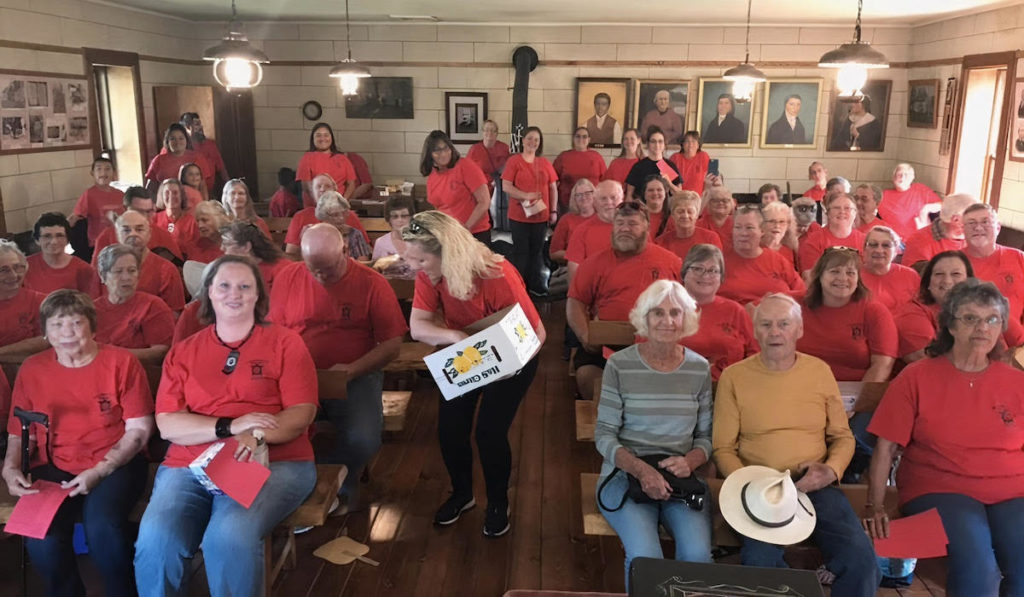
Sherri Clemmons felt like she was dreaming. Clemmons, the tribal heritage director for the Wyandotte Nation of Oklahoma, was in Upper Sandusky for the official transfer ceremony on Sept. 21, 2019. As she walked the streets, she made a mental map — that was where tribal leaders had lived, and down that street was the home of John Stewart.
After a service at the Methodist Church, a large stone building topped with red stucco, the crowd of about 200 locals and Wyandottes stepped into the soft September air to walk to the mission. They crossed Sandusky Avenue in a mass. All the traffic was stopped. Many members of the crowd wore outfits you might see anywhere in rural Oklahoma — blue jeans and University of Oklahoma baseball caps — but some of the women wore bright traditional dresses adorned with silver circles, and some of the men had tall, feathered headdresses.
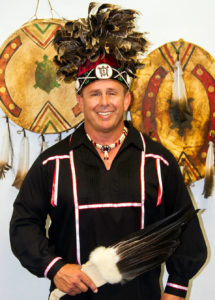
The crowd stopped twice — the first time at the “heathen’s cemetery,” where non-Methodist tribal members were buried, and then at the Old Indian Burial Grounds surrounding the church, where the Methodist Wyandottes are buried beneath crumbling headstones.
As the group walked into the mission, it felt like the end of a journey that had lasted decades.
Friend said afterward that he rejoiced in “knowing that we walked the same place our ancestors walked and being able to go in and worship the same place our ancestors worshiped in.”
The coronavirus pandemic interrupted Friend’s plans to bring more Wyandottes back to the mission over the past two years, but the transfer has been successful so far. The Wyandottes contributed another $20,000 for renovations, and both Friend and Bowen were eager for interns to begin visiting the mission in the summer again. Friend is looking into having the land placed in trust through the U.S. government.
Even though not much has changed practically, just knowing the land is in the name of the Wyandottes has had an impact on the tribe, said Clemmons, the tribal heritage director.
“To be able to go there myself, and sit where our people sat, and walk where they walked (…) it was such an eye-opener.”









